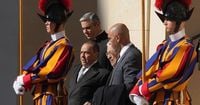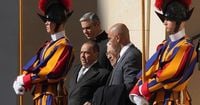On Thursday, November 6, 2025, a significant diplomatic encounter unfolded in Vatican City. Pope Leo XIV welcomed Palestinian President Mahmoud Abbas for their first-ever face-to-face meeting, a moment described by both Vatican officials and observers as not only historic but also deeply symbolic. The two leaders, representing both spiritual and political spheres, engaged in what the Holy See Press Office later characterized as “cordial” discussions. Their conversation, which lasted about an hour, centered on the urgent humanitarian crisis in Gaza and the enduring quest for peace in the region through a two-state solution.
This meeting came at a particularly delicate juncture. Nearly a month has passed since the U.S.-brokered ceasefire agreement took effect in the Gaza Strip—a fragile respite after years marked by violence, especially since the events of October 7, 2023, when Hamas launched attacks and Israel responded with forceful strikes. According to the Associated Press, Pope Leo XIV and President Abbas agreed that there is an “urgent need to provide assistance to the civilian population in Gaza.” The Holy See’s statement emphasized that both parties recognized the necessity of “ending the conflict by pursuing a two-State solution.”
For many, the symbolism of this meeting was heightened by its timing and setting. President Abbas was in Rome to commemorate the 10th anniversary of the Comprehensive Agreement between the Holy See and the State of Palestine, signed on June 26, 2015. This agreement, as reported by Vatican News, underscores both parties’ commitment to Palestinian self-determination and explicitly supports the two-state solution as the only viable path to lasting peace. Moreover, it highlights the spiritual and symbolic significance of Jerusalem for Jews, Christians, and Muslims alike—an acknowledgment of the city’s unique place in the hearts of millions worldwide.
Before his meeting with Pope Leo XIV, President Abbas made a poignant visit to the Basilica of St. Mary Major on Wednesday afternoon, November 5. There, he paid his respects at the tomb of the late Pope Francis. Accompanied by Egyptian Franciscan friar Ibrahim Faltas, a former Vicar of the Custody of the Holy Land, Abbas spent about fifteen minutes at the simple marble tomb inscribed with “Franciscus.” As he laid a bouquet of flowers, Abbas reflected on the late pontiff’s legacy, telling journalists, “I came to see Pope Francis because I cannot forget what he did for Palestine and for the Palestinian people, and I cannot forget that he recognized Palestine without anyone having to ask him to do so.”
The personal rapport between Abbas and the Vatican has built steadily over the years. Abbas met the late Pope Francis several times, especially in the wake of the 2023 crisis, maintaining frequent phone contact as violence surged in Gaza and the West Bank. However, until Thursday, he and Pope Leo XIV had only spoken by phone, most recently in July 2025 to discuss the ongoing conflict and the dire humanitarian situation in the region.
The discussions in the Apostolic Palace were shaped not only by the urgency of current events but also by the Vatican’s longstanding advocacy for peace in the Holy Land. In September 2025, as reported by the Associated Press, Pope Leo XIV and his top diplomats conveyed to Israel’s president that a two-state solution was “the only way out of the war.” The Vatican has consistently called for a permanent ceasefire in Gaza, urging all parties to prioritize humanitarian needs and to seek a diplomatic resolution grounded in mutual recognition and respect.
Observers note that the Vatican’s position carries both moral and diplomatic weight. The Holy See’s recognition of Palestine in 2015 was a landmark move, one that Abbas himself acknowledged with gratitude during his visit. The Comprehensive Agreement not only formalized relations between the Vatican and the State of Palestine but also set out principles for cooperation, protection of holy sites, and the rights of Christian communities in the region. It remains a touchstone for those seeking a peaceful and just resolution to the Israeli-Palestinian conflict.
During their meeting, Pope Leo XIV and President Abbas did not shy away from addressing the acute humanitarian needs in Gaza. The situation for civilians remains dire, with shortages of food, medicine, and essential services exacerbated by years of blockade and intermittent conflict. The leaders agreed on the immediate necessity of providing aid and called on the international community to step up its efforts. The Vatican’s statement reiterated that “there is an urgent need to provide assistance to the civilian population in Gaza.”
The conversation also turned to the broader prospects for peace. Both leaders reaffirmed their commitment to the two-state solution, a framework that envisions an independent State of Palestine existing peacefully alongside Israel. According to Vatican News, the 2015 Comprehensive Agreement “expresses both parties’ commitment to Palestinian self-determination and the two-state solution,” and it “stresses the symbolic and spiritual significance of Jerusalem for Jews, Christians, and Muslims alike.”
For President Abbas, the visit was not just a diplomatic gesture but also a moment of personal reflection and remembrance. His tribute to Pope Francis underscored the late pontiff’s role in advancing the Palestinian cause and in fostering interfaith dialogue. As he told reporters gathered outside St. Mary Major, “I cannot forget what he did for Palestine and for the Palestinian people.” The presence of Ibrahim Faltas, a figure deeply involved in the Franciscan mission in the Holy Land, further highlighted the enduring ties between the Vatican and the Palestinian leadership.
The significance of the meeting was not lost on the international community. Coming so soon after the latest ceasefire and amid renewed calls for a political settlement, the encounter between Pope Leo XIV and President Abbas sent a clear message: that humanitarian concerns and the pursuit of peace must remain at the forefront of global priorities. The Vatican’s advocacy for a two-state solution, combined with its moral authority, continues to shape the discourse around the Israeli-Palestinian conflict.
As the world watches events in the Middle East with hope and apprehension, Thursday’s meeting in the Vatican served as a reminder that dialogue and empathy remain essential tools for resolving even the most intractable conflicts. The path to peace is fraught with obstacles, but as Pope Leo XIV and President Abbas demonstrated, it is a journey that must be undertaken—one conversation, one gesture of solidarity, at a time.


